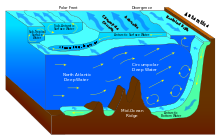Circumpolar Deep Water on:
[Wikipedia]
[Google]
[Amazon]
 Circumpolar Deep Water (CDW) is a designation given to the
Circumpolar Deep Water (CDW) is a designation given to the
 Circumpolar Deep Water (CDW) is a designation given to the
Circumpolar Deep Water (CDW) is a designation given to the water mass
An oceanographic water mass is an identifiable body of water with a common formation history which has physical properties distinct from surrounding water. Properties include temperature, salinity, chemical - isotopic ratios, and other physical ...
in the Pacific
The Pacific Ocean is the largest and deepest of Earth's five oceanic divisions. It extends from the Arctic Ocean in the north to the Southern Ocean (or, depending on definition, to Antarctica) in the south, and is bounded by the contine ...
and Indian oceans that is a mixing of other water masses in the region. It is characteristically warmer and saltier than the surrounding water masses, causing CDW to contribute to the melting of ice shelves in the Antarctic
The Antarctic ( or , American English also or ; commonly ) is a polar region around Earth's South Pole, opposite the Arctic region around the North Pole. The Antarctic comprises the continent of Antarctica, the Kerguelen Plateau and othe ...
region.
Physical Properties
CDW, the greatest volume water mass in theSouthern Ocean
The Southern Ocean, also known as the Antarctic Ocean, comprises the southernmost waters of the World Ocean, generally taken to be south of 60° S latitude and encircling Antarctica. With a size of , it is regarded as the second-smal ...
, includes the North Atlantic Deep Water
North Atlantic Deep Water (NADW) is a deep water mass formed in the North Atlantic Ocean. Thermohaline circulation (properly described as meridional overturning circulation) of the world's oceans involves the flow of warm surface waters from the ...
(NADW), the Antarctic Bottom Water (AABW), Antarctic Intermediate Water
Antarctic Intermediate Water (AAIW) is a cold, relatively low salinity water mass found mostly at intermediate depths in the Southern Ocean. The AAIW is formed at the ocean surface in the Antarctic Convergence zone or more commonly called the Ant ...
(AAIW), as well as recirculated deep water from the Indian and Pacific Oceans. A distinguishing characteristic of the CDW is that the water is not formed at the surface, but rather by a blending of other water masses. CDW sits at a depth of around 500 meters, approximately at the depth of the continental shelf
A continental shelf is a portion of a continent that is submerged under an area of relatively shallow water, known as a shelf sea. Much of these shelves were exposed by drops in sea level during glacial periods. The shelf surrounding an island ...
.
There are two types of CDW: Upper Circumpolar Deep Water (UCDW) and Lower Circumpolar Deep Water (LCDW). UCDW originates in the Indian and Pacific Oceans and has lower oxygen levels and higher nutrients than LCDW. LCDW comes from North Atlantic Deep Water and has a higher salinity. In the Indian Ocean, CDW has a temperature of 1.0 to 2.0°C. In the Pacific Ocean, it is slightly colder with a temperature of 0.1 to 2.0 °C. The salinity
Salinity () is the saltiness or amount of salt (chemistry), salt dissolved in a body of water, called saline water (see also soil salinity). It is usually measured in g/L or g/kg (grams of salt per liter/kilogram of water; the latter is dimensio ...
of CDW is 34.62 to 34.73 ‰
Per mille (from Latin , "in each thousand") is an expression that means parts per thousand. Other recognised spellings include per mil, per mill, permil, permill, or permille.
The associated sign is written , which looks like a percent ...
.
Because CDW is a mix of other water masses, its temperature-salinity (TS) profile is the point where the TS lines of the other water masses converge. TS diagrams refer to temperature and salinity profiles, which are one of the major ways water masses are distinguished from each other. The convergence of the TS lines thus proves the mixing of the other water masses.
Influence on Antarctic ecosystems and ice shelves
CDW plays an important role in the Antarctic Circumpolar Current (ACC) because it contributes to the melting of the base of ice shelves.{{Cite journal, last1=Dinniman, first1=Michael S., last2=Klinck, first2=John M., last3=Smith, first3=Walker O., date=2011, title=A model study of Circumpolar Deep Water on the West Antarctic Peninsula and Ross Sea continental shelves, url=https://www.sciencedirect.com/science/article/pii/S0967064510003711, journal=Deep Sea Research Part II: Topical Studies in Oceanography, series=, language=en, volume=58, issue=13, pages=1508–1523, doi=10.1016/j.dsr2.2010.11.013, bibcode=2011DSRII..58.1508D, issn=0967-0645 Glaciers ending in CDW have melted considerably while glaciers in the northwest, with no CDW, have not. The CDW is salty and slightly above freezing temperature, which is warm compared to ice shelves. When the CDW flows upward onto the continental shelf and travels through the deep canyons, it reaches the underside of the ice shelves. The warmer water makes contact with the shelves, contributing to the ice shelf melting and consequently sea level rise. Gradients around Antarctica formed between shelf water and CDW are called the Antarctic Slope Front. The CDW also plays an important role in supporting Antarctic ecosystems.Upwelling
Upwelling is an physical oceanography, oceanographic phenomenon that involves wind-driven motion of dense, cooler, and usually nutrient-rich water from deep water towards the ocean surface. It replaces the warmer and usually nutrient-depleted ...
of the CDW onto the Antarctic continental shelves brings heat and nutrients that support ecosystems along the west Antarctic Peninsula
The Antarctic Peninsula, known as O'Higgins Land in Chile and Tierra de San Martín in Argentina, and originally as Graham Land in the United Kingdom and the Palmer Peninsula in the United States, is the northernmost part of mainland Antarctic ...
.
References